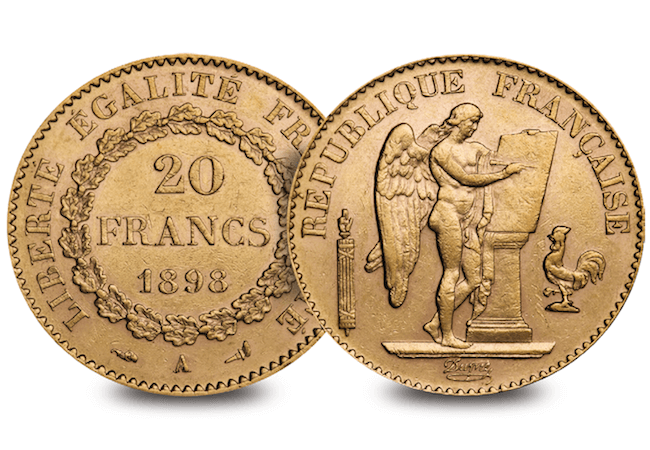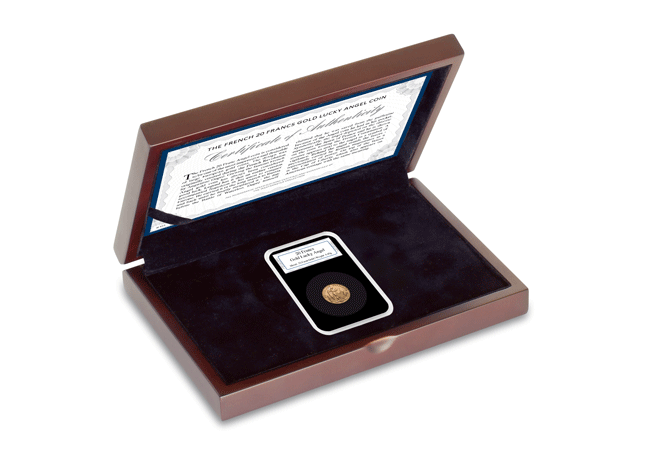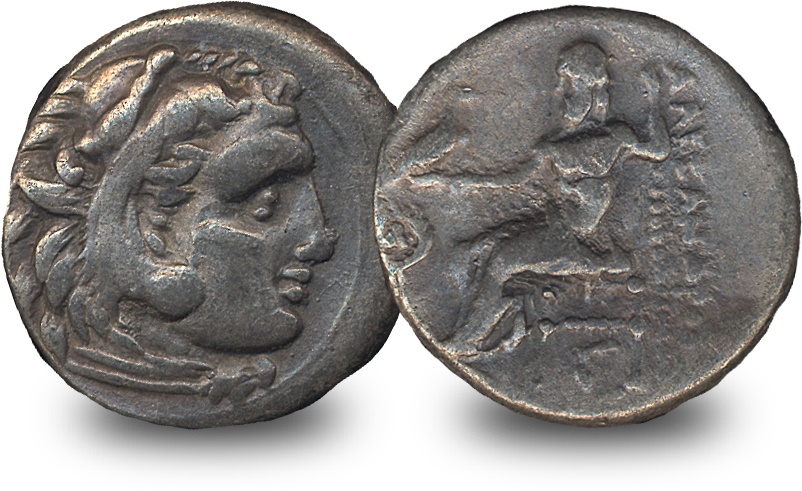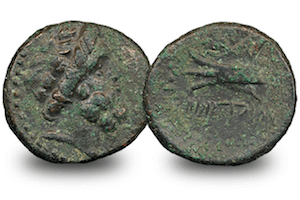Ancient Coins
Discover the coins that built the British Empire
The East India Company is living proof of Sir Walter Raleigh’s (1614) prophetic words: “whosoever commands the sea, commands the trade, whosoever commands the trade of the world commands the riches of the world and consequently the world itself,” as they rapidly became a trading force to be reckoned with.
And coins were one of the key ways the company managed trade across the globe.
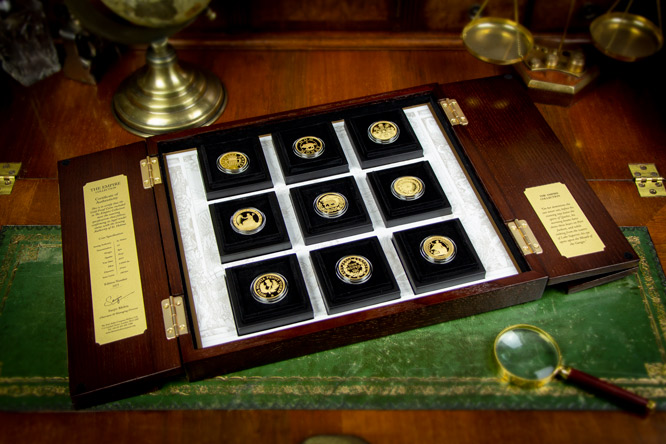
At its peak the EIC was single-handedly responsible for half the world’s trade, including cotton, silk, spices, opium and tea.
Remarkably, the East India Company is still trading today. And they have just authorised a set of limited edition Gold coins paying tribute to the most important coins in their history.
Here is the story behind the coins…
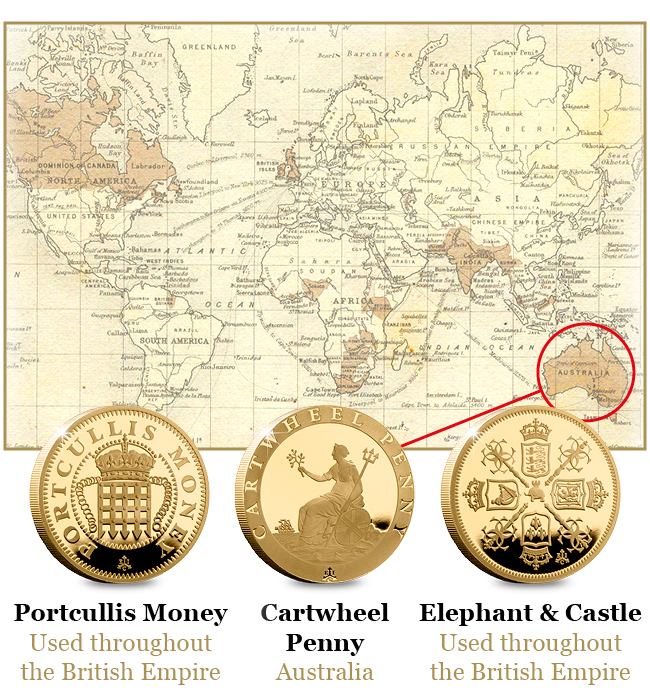
Portcullis Money – 1601 (Throughout the Empire)
Ordered by Queen Elizabeth I to facilitate increased commerce on behalf of the British Crown and to compete against the widely used Spanish Real. These were the first coins issued for the British Empire outside of England’s normal coinage.
The Cartwheel Penny – 1797 (Australia)
The Cartwheel Penny was the first British coin to be exported to Australian Colonies. It was introduced to help curb Britain’s chronic coin shortage which was impacting economic growth. Specially designed to prevent counterfeiting, and the thick rim and inscription led to the pennies being informally named ‘The Cartwheel Penny’.
The Elephant and Castle Guinea – 1663 (Throughout the Empire)
The guinea is regarded as the most successful trade coin, exponentially increasing British and local trade wherever it was introduced. This Guinea was the first British machine-struck coin, and adopted its name from where the gold was mined from.
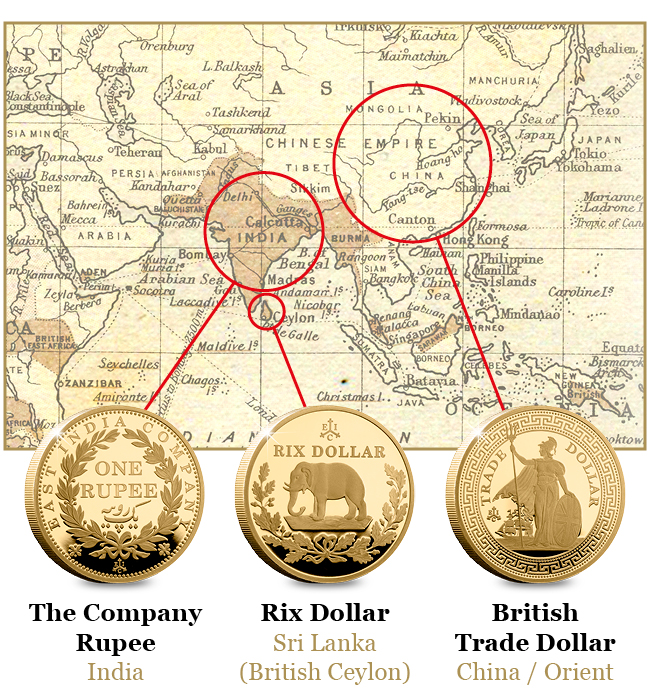
The Company Rupee – 1833 (India)
The Rupee is one of the world’s oldest systems of money. It was adopted by the East India Company upon its arrival in the East, and soon became one of the company’s most important coins and means for trade. In 1833 reforms to the Indian weights and measures led to coinage in India changing from the Sicca to the standard ‘Company Rupee’.
The Rix Dollar – 1821 (Sri Lanka)
Great Britain sought to develop Ceylon’s (Sri Lanka’s) economy and increase trade to and from Europe. As a part of this aim The Rix Dollar was struck specifically for use in Ceylon. Designed by Benedetto Pistrucci, who is also responsible for the now iconic rendition of St. George slaying the Dragon which features on British Sovereigns.
The British Trade Dollar – 1839 (The Orient)
To facilitate the trade of their most lucrative commodities, namely tea and opium a trading post in Canton, China was established. During the Trade Wars Great Britain found itself having to rely more and more on its own silver coinage, and this paved the way for one of the most distinctive silver British coins in numismatic history to be struck: the British Trade Dollar.
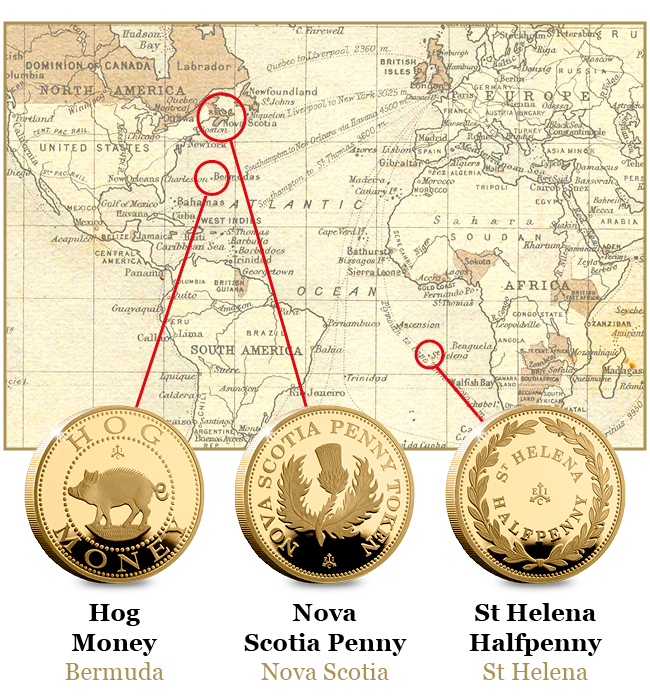
Hog Money – 1609 (Bermuda)
In order to develop Bermuda’s prosperous economy King James I granted permission to mint coins, which resulted in the issuing of Hog Money, inspired by the wild hogs previously introduced to the island, it’s the first English coin to be minted specifically for use in North America.
The St Helena Halfpenny – 1821 (St Helena)
In 1815 St Helena’s economy benefited from the arrival of the former French Emperor, Napoleon, during his second exile, as the famous prisoner brought with him an entourage of British troops, effectively doubling the islands population and prosperity. As the economy swelled, St Helena’s first local coins were introduced.
The Nova Scotia Penny – 1823 (Canada)
Prior to the Canadian Confederation in 1867 many provinces issued their own coinage. However in 1823, without seeking official approval from the Home Office, the province of Nova Scotia ordered the issuing of coins. The coins, issued in denominations of one pennies and halfpennies, contributed to the expansion of local commerce in Nova Scotia.
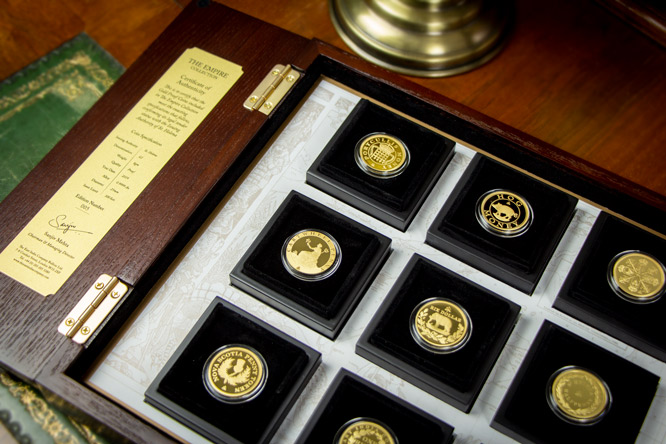
The 2019 Empire Collection
For this exceptional 2019 issue collectors will be taken on a journey to the far flung corners of the world. Retracing the steps of the East India Company, to discover some of the most significant coins which have helped build an empire stretching across three centuries from 1600 to the Victorian Era.
Finished to an exceptionally high standard, the 2019 collection truly represents the global resonance of The East India Company and these significant coins. There is no doubt the 2019 Empire Collection is going to become a future collector priority.
If you are interested…
Out of a Worldwide edition limit of just 100 we have a small stock of the 2019 Empire Collection available. If you are interested in owning a set – please complete the form below and we will contact you directly.
Your message has been sent
Will these coins bring you luck?
Do you believe in luck? Have you ever owned an item you consider lucky, such as a piece of clothing or perhaps a coin?
Money in general has been considered a source of luck for hundreds of years, such as the lucky penny or the action of throwing money into a fountain to bring fortune. Now let me tell you about a very special ‘lucky’ coin.
The Lucky Angel Coin is one of the most impressive and desirable of all European gold coins, not only due to its beautiful design, but because it is thought to bring such great luck.
The Design:
- The angel depicted on the obverse represents the Spirit of France and is shown writing the French Constitution.
- A rooster appears next to the angel as a symbol of vigilance.
- Behind the angel stands the fasces – previously carried by Roman magistrates as a representation of power.
- On top of this is the Cap of Liberty.
Let’s start at the beginning.
Legend has it that an earlier version of this coin accompanied Napoleon in his rise to power in France and on each heroic campaign, until he arrogantly flung his coin into the river… on the eve of the Battle of Waterloo, in which he was defeated and ended his rule as the French Emperor!
This coin was then re-created during the French Revolution and Augustin Dupré was commissioned by King Louis XVI to design it. He was a firm believer in the power of guardian angels and incorporated this theme into his design.
Years later he fell out of favour with the king and was condemned to death. Dupré claimed that the Angel coin saved him from the guillotine because he had it in his pocket. He said a quick prayer as he knelt beneath the deadly blade and rubbed his coin for good luck. Suddenly a bolt of lightning struck nearby, causing a panic and halting his execution! Before it could be rescheduled, Dupré was granted a pardon, his life saved.
From that moment on it became known as the ‘Angel Coin’ and many stories were told of the wonders of the coin.
Fishermen never went to sea without it, WWI French pilots never flew without it.
Even pilots from Britain and the United States carried the French coins into battle with them. US pilots continued to put their faith in the coin’s protective powers during the Korean and Vietnam Wars.
In fact, the legend of these coins carried such weight that Hermann Goering, the engineer of Hitler’s evil vision, ordered his soldiers to round them up and had them buried in a location that has never been discovered.
The legend continues.
To this day, many pilots, rescue and police heroes proclaim the Angel’s power of luck and protection.
Some blame the coin’s remarkable good fortune on coincidence, others luck, and others a reward for faith. Who knows what these coins actually do, but their legend in itself is enough to want to own one!
If you’re interested…
You have the unique chance to own the world’s luckiest coin… will you be lucky enough to secure one? Click here to find out more
The coins behind the Ancient Greek myths…
Ancient Greek civilisation provided the foundations for Western culture. One of the empire’s most recognised legacies is Greek mythology, which had an extensive influence on arts and literature in the West. Greek myths tended to describe the lives of Greek Gods including their births, victories in battle, love affairs and their connection to certain city-states.
One artifact which pays homage to Greek mythology is Ancient Greek coinage. Greek currency was the first to be minted on an imperial scale and has influenced commerce across the world.
Coins were hugely important as a medium of exchange and an important store of value and source of prestige. Greek coins used a combination of figures, symbols and inscriptions to symbolise each ruler’s territory. Each city state in Ancient Greece was said to be protected by a certain character from Greek mythology and one of the most identifiable features of Greek coinage are the Gods and Goddesses which are struck on many of the coins of the time.
I have taken a look at some of the most famous myths that were struck on coins from the time, some over 2,000 years old!
Zeus ‘King of the Gods’
Issued in the 2nd century BC this coin depicts Zeus the chief of the gods and believed to be the ruler of mankind. It’s believe that Zeus saved his brothers, Poseidon and Hades, after they had been eaten by their father Cronus. The three of them divided creation between them. As the Father God, Zeus was the dispenser of good and evil and the upholder of morality.
Hercules ‘Son of Zeus‘
Alexander the Great often issued coins depicting himself dressed as Hercules, wearing a headdress made of the scalp of the Nemean lion – one of Hercules’ “12 tests”. Hercules is famed for being the strongest of all mortals. However, his physical power was offset by a lack of intelligence and strong emotions. Many of Hercules’ great deeds occurred while doing penance for stupid acts done in anger or carelessness.
Apollo ‘God of Music’

The Ancient Greek Apollo ‘God of Music’ Coin
This coin is an example of one of many coins issued depicting Apollo, the son of Zeus. Apollo is considered a complex god of many things including music, poetry, art, oracles, archery, plague, medicine, sun, and knowledge. He is often depicted playing the lyre and is represented as an ever youthful god.
Ares ‘God of War’
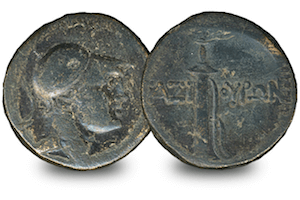
The Ancient Greek Ares ‘God of War’ Coin
Issued in the 1st Century BC this coin depicts Ares, the God of war and violence. Fittingly the reverse of this coin features a sword. Ares was a superior fighter in battle and caused great bloodshed and destruction, but he also had a reputation for being cowardly.
The Dioscuri ‘Patron Saint of Sailors’

The Ancient Greek Dioscuri ‘Patron Saints of Sailors’ Coin
This coin features the Dioscuri; the twin brothers of Castor and Pollux. Pollux, the son of Zeus, was immortal but Castor was mortal. When Castor was murdered, Pollux asked his father Zeus if he could share his immortality with his brother. So they transformed into the constellation Gemini, able to travel back and forth between Olympus and Hades. They are also known as protectors of sailors, able to calm the seas and winds in storms.
Gorgon ‘Medusa’

The Ancient Greek Gorgon ‘Medusa’ Coin
Medusa was the only mortal of the three powerful winged Gorgon sisters. It is believed that Medusa was transformed into a monster by Athena. Medusa’s hair was made of snakes, although it is depicted as wild leaves on this coin, and she was said to be able to turn people to stone with a glance. She was killed by the hero Perseus, who used the metal of his shield as a mirror to avoid eye contact with Medusa.
Histiaea ‘Patron Saint of Histiaea’

The Ancient Greek Histiaea ‘Patron Saint of Histiaea’ Coin
This small silver coin is known as a “tertobol” and weighs just over 2 grams. It pictures Histiaea, the nymph, on both the obverse and reverse. Histiaea was named after the ancient city of Histiaea on the second largest Greek island, Euboea. Mythical Naiads lived in the lakes here and being immortal, were invited to the assemblies of the gods on Mount Olympus.
Poseidon ‘God of the Sea’

The Ancient Greek Poseidon ‘God of the Sea’ Coin
Poseidon was worshipped as the god of the sea, earthquakes and horses. Poseidon is often portrayed with his best known weapon, the trident, which he used to shake the earth and create storms, causing devastating earthquakes and tsunamis. It is this trident that is featured on the reverse of this coin. The coin was issued by the Syracuse in the 3rd Century BC, as Poseidon was greatly important to them as a maritime city/state.
Tyche ‘Goddess of Cities’

The Ancient Greek Tyche ‘Goddess of Cities’ Coin
Tyche was the personification of fortune and controlled the luck and prosperity of a city. On this coin she is depicted with a crown of city walls and the reverse depicts a cornucopia, a symbol of good fortune. Tyche was said to have carried a large horn containing riches, which she would sporadically spread to individuals and cities. When no cause could be discovered for events such as floods, droughts or political upheaval, they were often attributed to Tyche.
If you’re interested…
Now you have the chance to own The Zeus ‘King of Gods’ Bronze Coin, which is over 2000 years old. How many people can say they own a piece of ancient history whose story has had such impact on the world today?
So if you want one, click here for details before they sell out.

